Two new hives of honeybees residing, pollinating in Camden
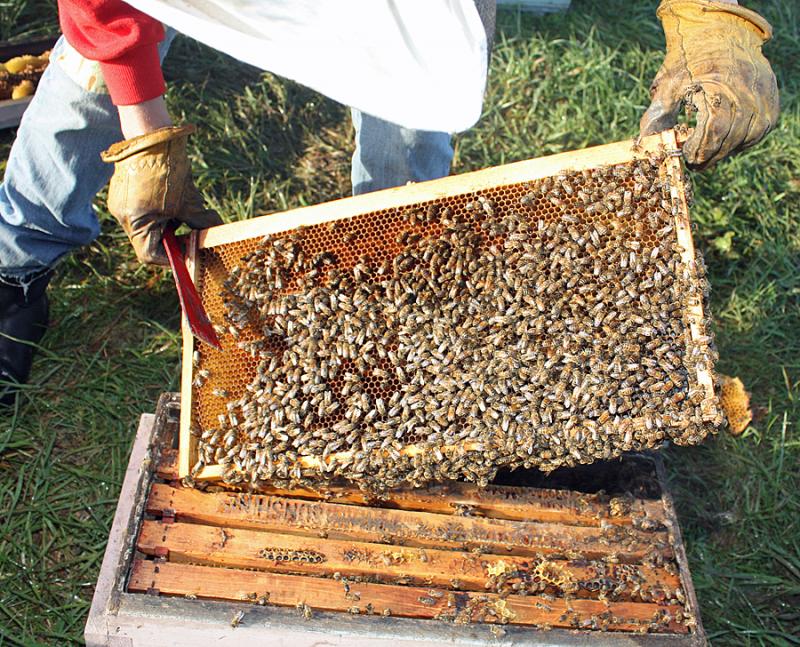 Khara Matcham lifts a frame of Sunshine Apiary honeybees from the nucleus box and inspects it before transferring into our deep hive body box at Humble Abodes woodenware in Windsor May 28. (Photo by Holly S. Edwards)
Khara Matcham lifts a frame of Sunshine Apiary honeybees from the nucleus box and inspects it before transferring into our deep hive body box at Humble Abodes woodenware in Windsor May 28. (Photo by Holly S. Edwards)
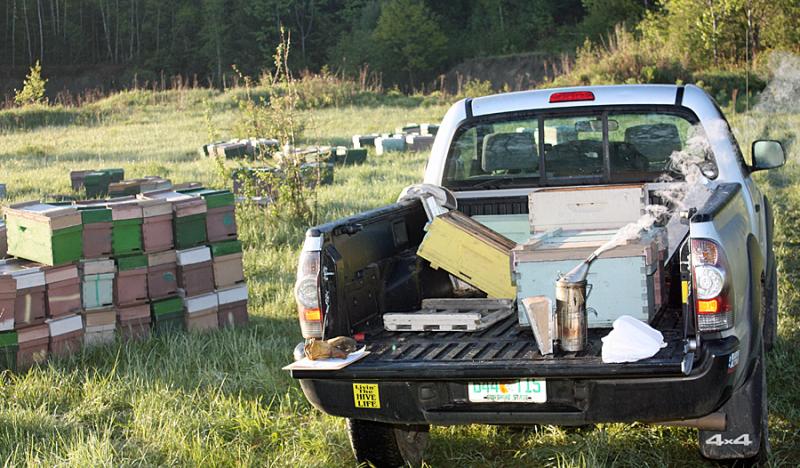 Stacks of nucleus boxes await us in the fields at Humble Abodes woodenware supplier in Windsor. (Photo by Zak Edwards)
Stacks of nucleus boxes await us in the fields at Humble Abodes woodenware supplier in Windsor. (Photo by Zak Edwards)
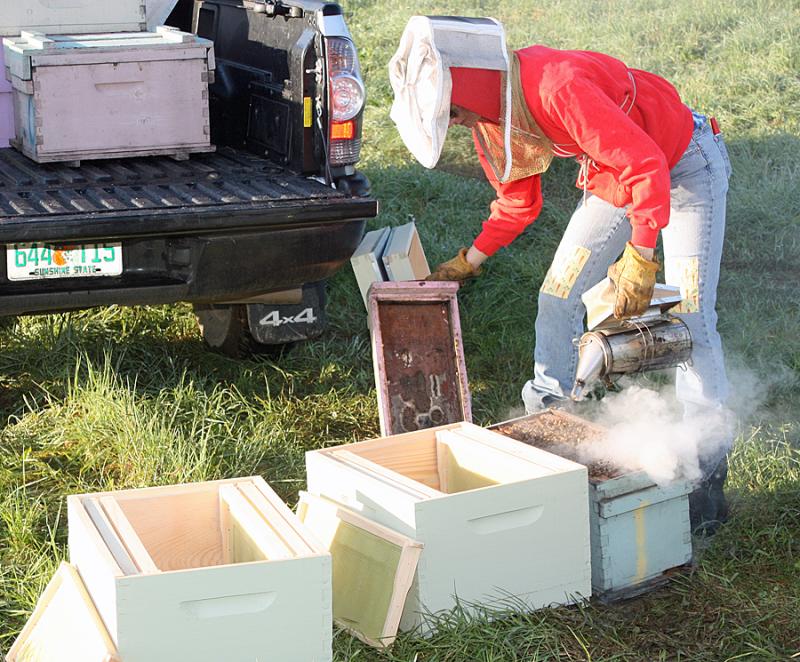 Khara Matcham, who raises queen bees when she's not delivering honeybees for Sunshine Apiary, smokes the bees in the box to settle them and push them back inside. (Photo by Holly S. Edwards)
Khara Matcham, who raises queen bees when she's not delivering honeybees for Sunshine Apiary, smokes the bees in the box to settle them and push them back inside. (Photo by Holly S. Edwards)
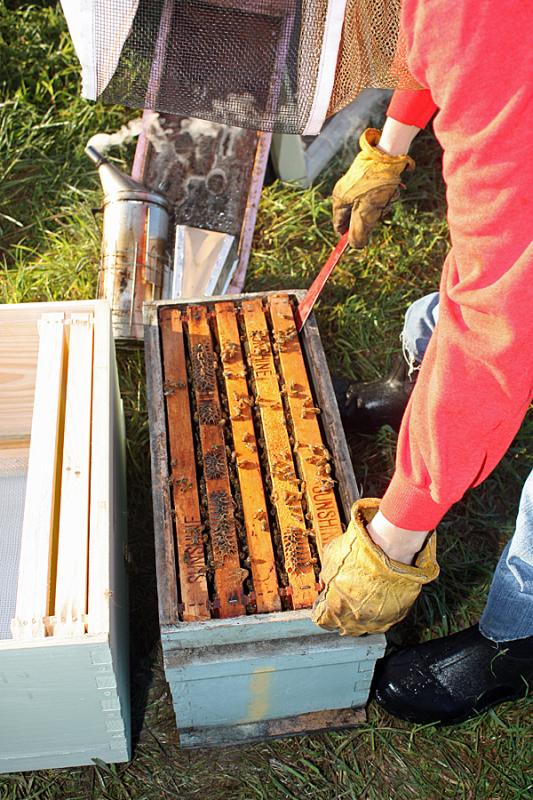 Khara Matcham uses a hive tool to pry apart frames "glued" together with propolis by the bees. (Photo by Holly S. Edwards)
Khara Matcham uses a hive tool to pry apart frames "glued" together with propolis by the bees. (Photo by Holly S. Edwards)
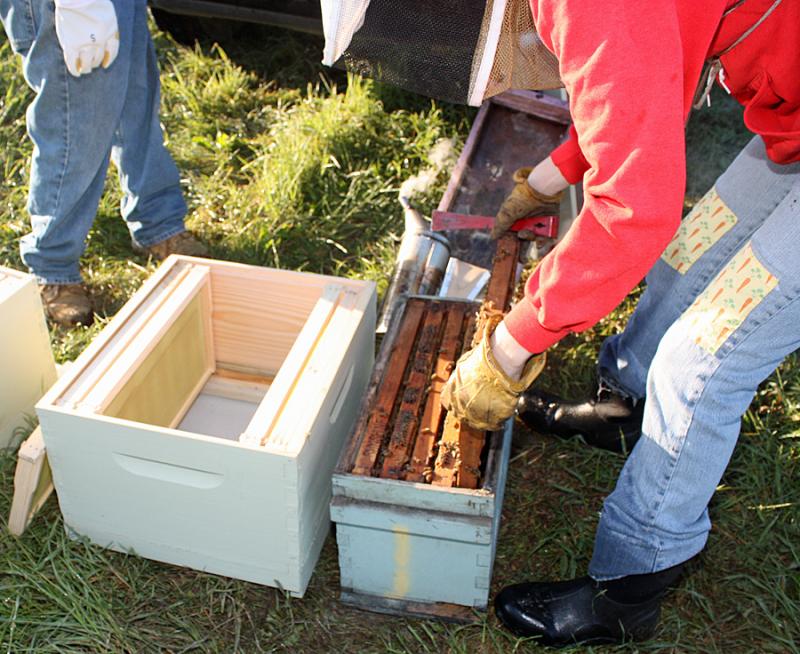 Frames are lifted out of the nucleus box, one at a time, and then placed into the adjacent deep hive body in the same order. (Photo by Holly S. Edwards)
Frames are lifted out of the nucleus box, one at a time, and then placed into the adjacent deep hive body in the same order. (Photo by Holly S. Edwards)
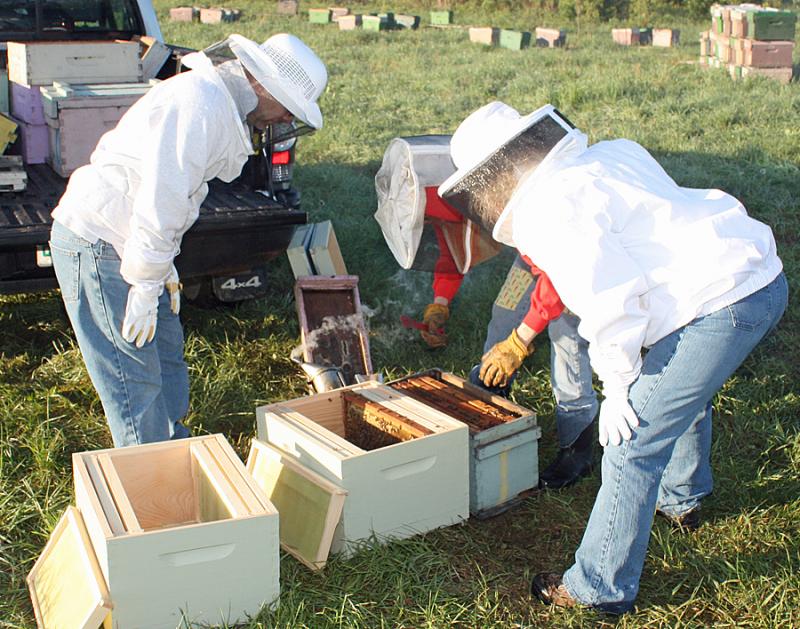 My husband, Dave, and I get a close look at our bees as beekeeper Khara Matcham pulls out frames for inspection. (Photo by Zak Edwards)
My husband, Dave, and I get a close look at our bees as beekeeper Khara Matcham pulls out frames for inspection. (Photo by Zak Edwards)
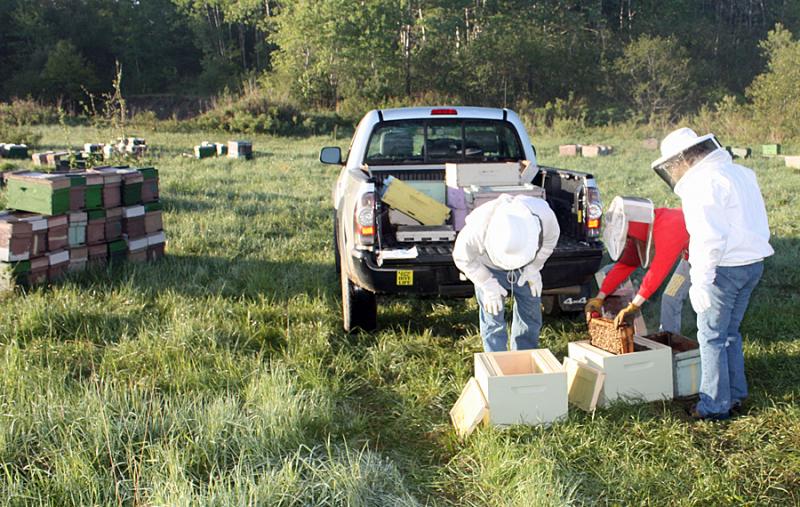 (Photo by Zak Edwards)
(Photo by Zak Edwards)
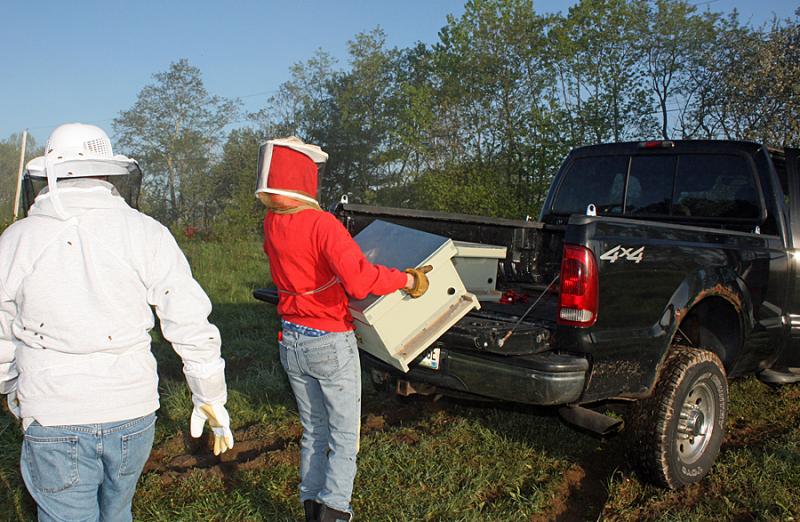 Loading up our bees into the back of our truck. (Photo by Zak Edwards)
Loading up our bees into the back of our truck. (Photo by Zak Edwards)
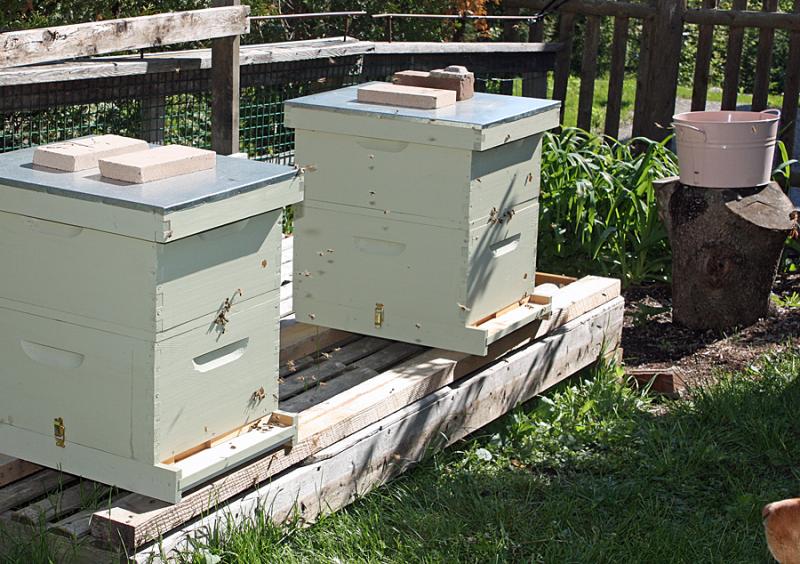 Our hives set up in Camden, and as the sun begins to warm the boxes, the bees begin taking orientation flights. (Photo by Holly S. Edwards)
Our hives set up in Camden, and as the sun begins to warm the boxes, the bees begin taking orientation flights. (Photo by Holly S. Edwards)
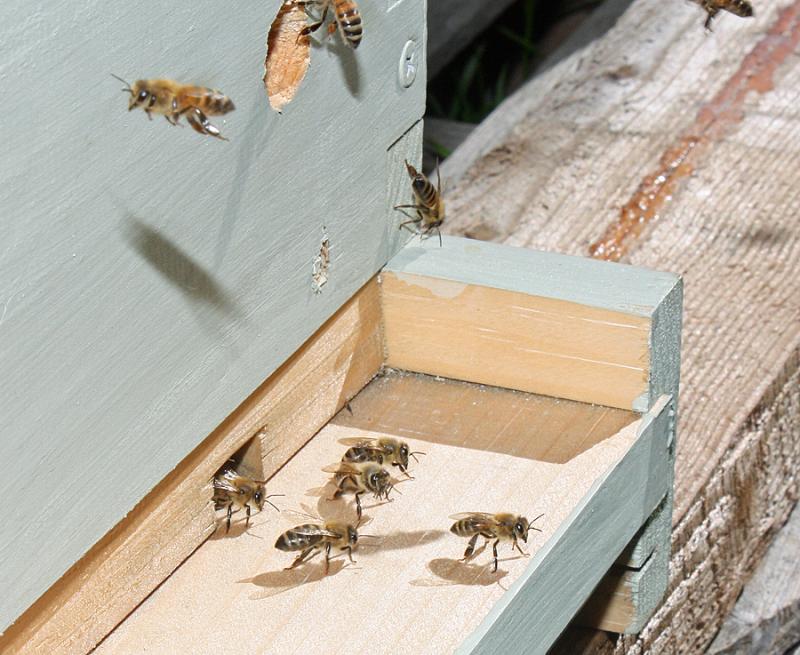 Marching out the entrance, preparing for takeoff... (Photo by Holly S. Edwards)
Marching out the entrance, preparing for takeoff... (Photo by Holly S. Edwards)
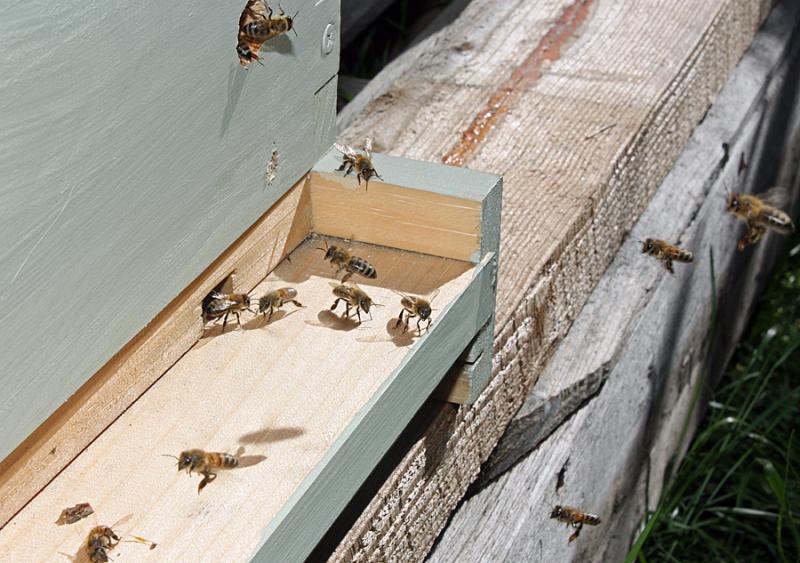 And then the flying back and forth really started in earnest. By noon, many would be coming back, their back legs laden with bright yellow pollen. (Photo by Holly S. Edwards)
And then the flying back and forth really started in earnest. By noon, many would be coming back, their back legs laden with bright yellow pollen. (Photo by Holly S. Edwards)
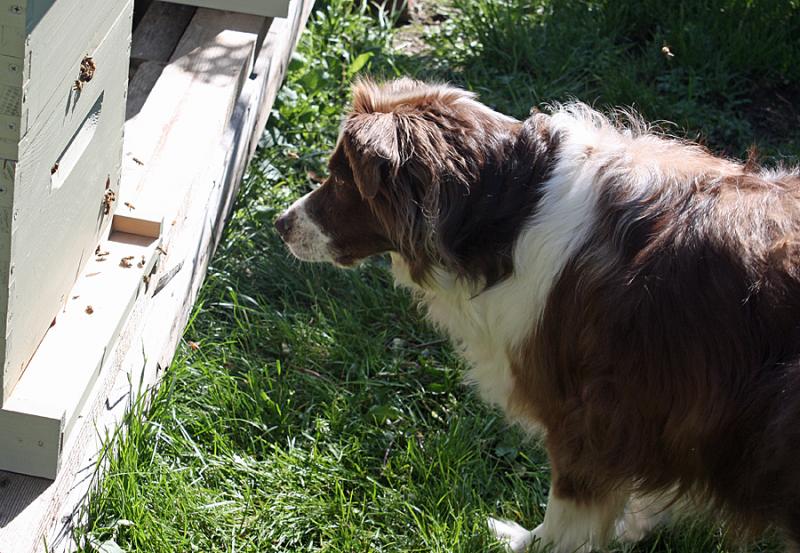 My old girl, Sydney, checks out the bees. (Photo by Holly S. Edwards)
My old girl, Sydney, checks out the bees. (Photo by Holly S. Edwards)
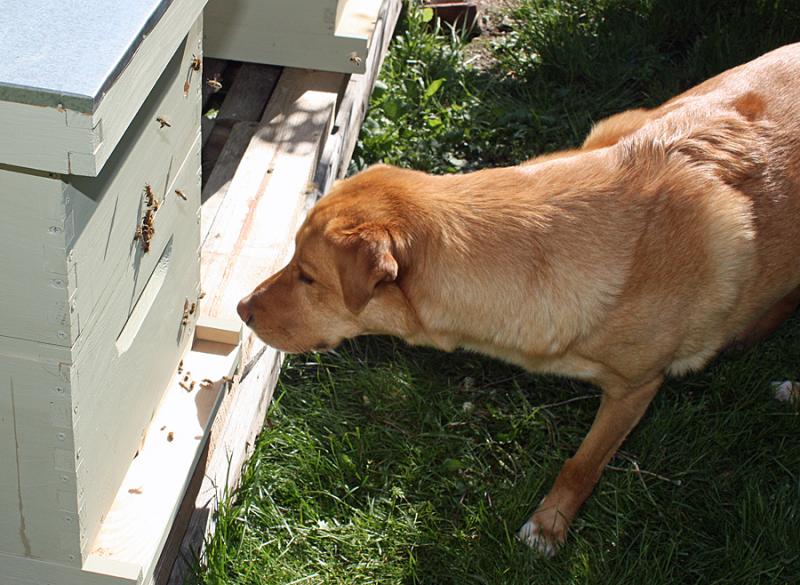 Shnuck checks out the bees too, only he got much closer... (Photo by Holly S. Edwards)
Shnuck checks out the bees too, only he got much closer... (Photo by Holly S. Edwards)
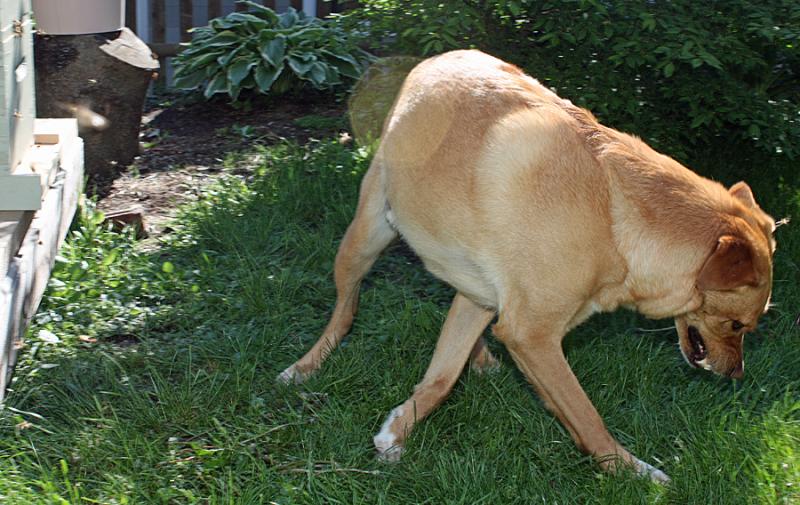 ...and then Shnuck starting trying to eat them, which resulted in a sting inside his mouth. And yes, he keeps going back for more, silly dog. (Photo by Holly S. Edwards)
...and then Shnuck starting trying to eat them, which resulted in a sting inside his mouth. And yes, he keeps going back for more, silly dog. (Photo by Holly S. Edwards)
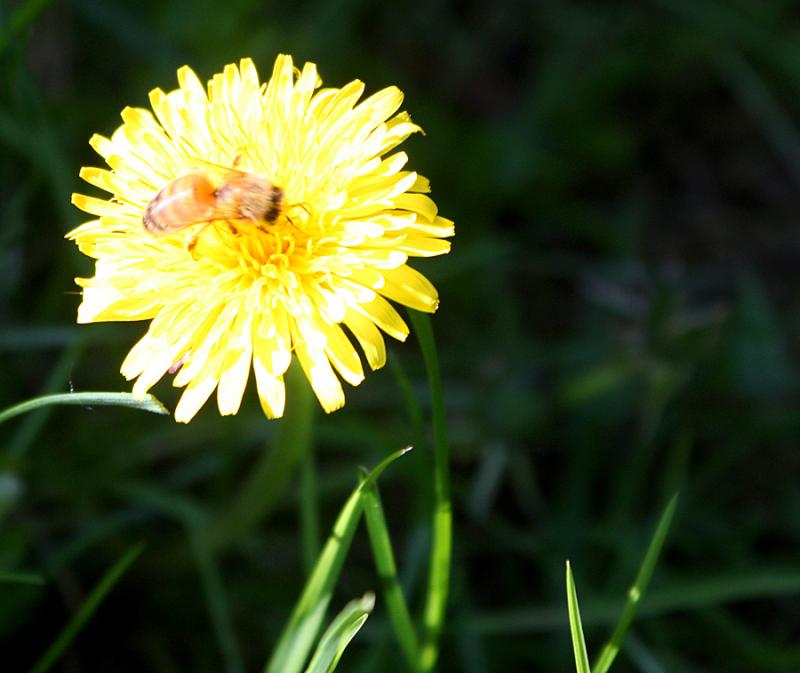 One of our "girls" on a dandelion in the backyard, not far from the hive. (Photo by Holly S. Edwards)
One of our "girls" on a dandelion in the backyard, not far from the hive. (Photo by Holly S. Edwards)
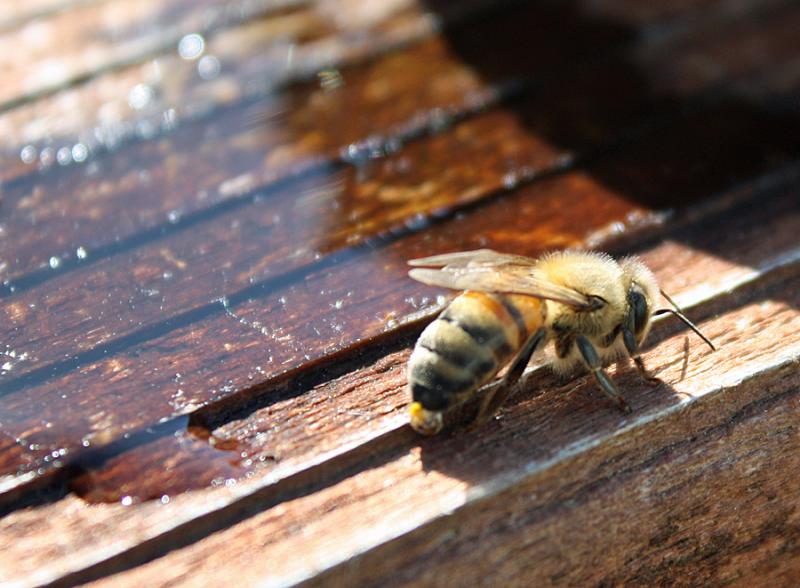 Another honeybee up on the deck. (Photo by Holly S. Edwards)
Another honeybee up on the deck. (Photo by Holly S. Edwards)
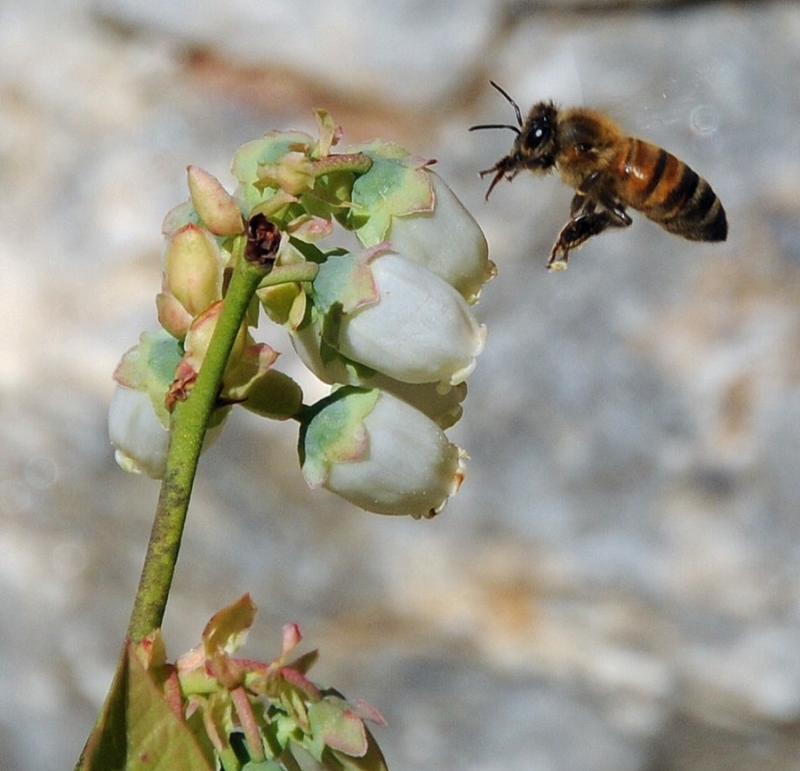 One of "girls" discovering the Gale's blueberry bushes, behind our house. (Courtesy Charles and Carol Gale)
One of "girls" discovering the Gale's blueberry bushes, behind our house. (Courtesy Charles and Carol Gale)
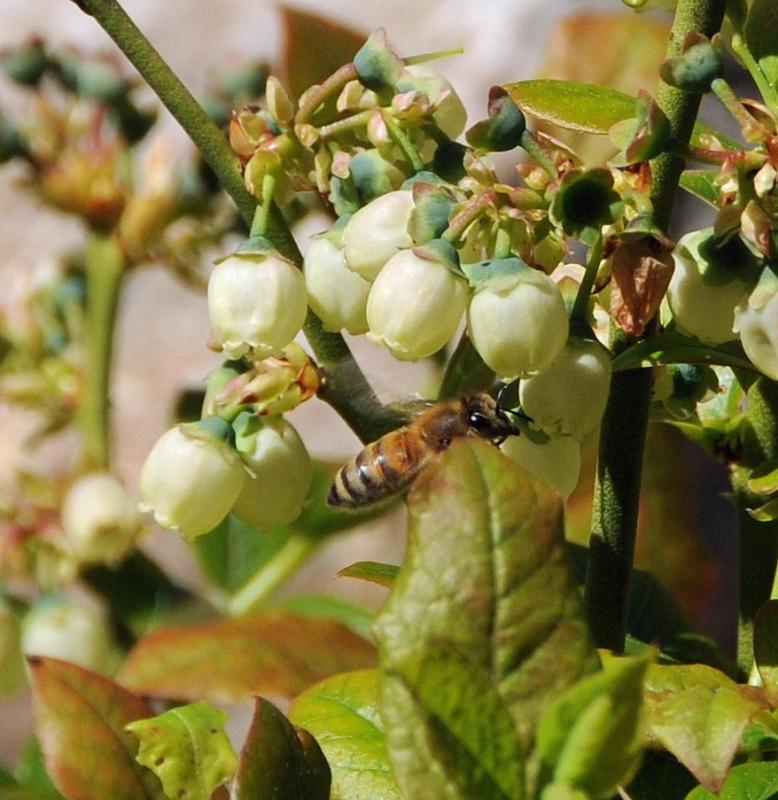 A honeybee and blueberry bush meeting. (Courtesy Charles and Carol Gale)
A honeybee and blueberry bush meeting. (Courtesy Charles and Carol Gale)
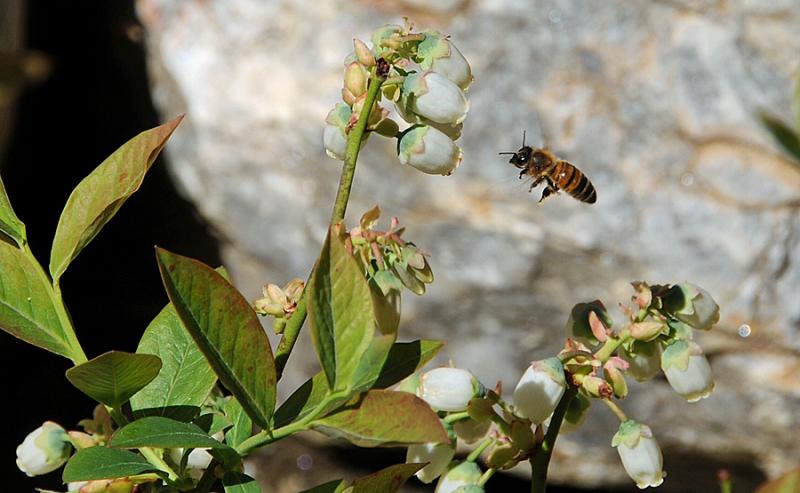 Another photo of one of our new honeybees discovering our neighbor's blueberry bushes. (Courtesy Charles and Carol Gale)
Another photo of one of our new honeybees discovering our neighbor's blueberry bushes. (Courtesy Charles and Carol Gale)
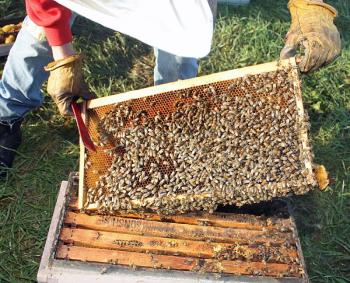 Khara Matcham lifts a frame of Sunshine Apiary honeybees from the nucleus box and inspects it before transferring into our deep hive body box at Humble Abodes woodenware in Windsor May 28. (Photo by Holly S. Edwards)
Khara Matcham lifts a frame of Sunshine Apiary honeybees from the nucleus box and inspects it before transferring into our deep hive body box at Humble Abodes woodenware in Windsor May 28. (Photo by Holly S. Edwards)
 Stacks of nucleus boxes await us in the fields at Humble Abodes woodenware supplier in Windsor. (Photo by Zak Edwards)
Stacks of nucleus boxes await us in the fields at Humble Abodes woodenware supplier in Windsor. (Photo by Zak Edwards)
 Khara Matcham, who raises queen bees when she's not delivering honeybees for Sunshine Apiary, smokes the bees in the box to settle them and push them back inside. (Photo by Holly S. Edwards)
Khara Matcham, who raises queen bees when she's not delivering honeybees for Sunshine Apiary, smokes the bees in the box to settle them and push them back inside. (Photo by Holly S. Edwards)
 Khara Matcham uses a hive tool to pry apart frames "glued" together with propolis by the bees. (Photo by Holly S. Edwards)
Khara Matcham uses a hive tool to pry apart frames "glued" together with propolis by the bees. (Photo by Holly S. Edwards)
 Frames are lifted out of the nucleus box, one at a time, and then placed into the adjacent deep hive body in the same order. (Photo by Holly S. Edwards)
Frames are lifted out of the nucleus box, one at a time, and then placed into the adjacent deep hive body in the same order. (Photo by Holly S. Edwards)
 My husband, Dave, and I get a close look at our bees as beekeeper Khara Matcham pulls out frames for inspection. (Photo by Zak Edwards)
My husband, Dave, and I get a close look at our bees as beekeeper Khara Matcham pulls out frames for inspection. (Photo by Zak Edwards)
 (Photo by Zak Edwards)
(Photo by Zak Edwards)
 Loading up our bees into the back of our truck. (Photo by Zak Edwards)
Loading up our bees into the back of our truck. (Photo by Zak Edwards)
 Our hives set up in Camden, and as the sun begins to warm the boxes, the bees begin taking orientation flights. (Photo by Holly S. Edwards)
Our hives set up in Camden, and as the sun begins to warm the boxes, the bees begin taking orientation flights. (Photo by Holly S. Edwards)
 Marching out the entrance, preparing for takeoff... (Photo by Holly S. Edwards)
Marching out the entrance, preparing for takeoff... (Photo by Holly S. Edwards)
 And then the flying back and forth really started in earnest. By noon, many would be coming back, their back legs laden with bright yellow pollen. (Photo by Holly S. Edwards)
And then the flying back and forth really started in earnest. By noon, many would be coming back, their back legs laden with bright yellow pollen. (Photo by Holly S. Edwards)
 My old girl, Sydney, checks out the bees. (Photo by Holly S. Edwards)
My old girl, Sydney, checks out the bees. (Photo by Holly S. Edwards)
 Shnuck checks out the bees too, only he got much closer... (Photo by Holly S. Edwards)
Shnuck checks out the bees too, only he got much closer... (Photo by Holly S. Edwards)
 ...and then Shnuck starting trying to eat them, which resulted in a sting inside his mouth. And yes, he keeps going back for more, silly dog. (Photo by Holly S. Edwards)
...and then Shnuck starting trying to eat them, which resulted in a sting inside his mouth. And yes, he keeps going back for more, silly dog. (Photo by Holly S. Edwards)
 One of our "girls" on a dandelion in the backyard, not far from the hive. (Photo by Holly S. Edwards)
One of our "girls" on a dandelion in the backyard, not far from the hive. (Photo by Holly S. Edwards)
 Another honeybee up on the deck. (Photo by Holly S. Edwards)
Another honeybee up on the deck. (Photo by Holly S. Edwards)
 One of "girls" discovering the Gale's blueberry bushes, behind our house. (Courtesy Charles and Carol Gale)
One of "girls" discovering the Gale's blueberry bushes, behind our house. (Courtesy Charles and Carol Gale)
 A honeybee and blueberry bush meeting. (Courtesy Charles and Carol Gale)
A honeybee and blueberry bush meeting. (Courtesy Charles and Carol Gale)
 Another photo of one of our new honeybees discovering our neighbor's blueberry bushes. (Courtesy Charles and Carol Gale)
Another photo of one of our new honeybees discovering our neighbor's blueberry bushes. (Courtesy Charles and Carol Gale)
CAMDEN — It's official. Tuesday morning, May 28, we became the proud keepers of 22,000 honeybees, give or take a few thousand.
We loaded up the truck with two of our deep hive boxes, with only half the frames on which the honeybees would eventually draw out honeycomb and fill it with brood and honey. We secured the bottom boards, as instructed, covered the entrance holes we drilled into each box and used tie-downs to secure the outer covers on top.
Luckily, we did this Memorial Day night, Monday, because the alarm woke us up at 4:15 a.m. Tuesday and we had to hit the road to Windsor by 5:15 a.m. We had a 6:30 a.m. appointment with the honeybee wrangler at Sunshine Apiary and since we are newbies, we had only a vague idea of what we would find when we got there.
This adventure began as a Valentine's Day present. It was the start of the "Surprise Fridays," which I stopped four weeks in when I came home to an adopted rat terrier, rescued from an overcrowded shelter in Arkansas. But backing up four weeks, for the inaugural Surprise Friday, my husband said we were going to a potluck dinner in Rockport Feb. 15, but he wouldn't say where or with who or why.
"What should I wear?" Dressy casual, but comfortable. "What should I bring for the potluck?" Whatever tastes good and is easy to make.
It turns out the get-together was a winter meeting of the Knox Lincoln County Beekeepers Club and this was to be an introduction to beginning beekeeping. Following a plentiful supper and introductions to a room full of strangers, we sat and listened to Peter Lammert of Thomaston talk to the group about lots of honeybee-related things we had no clue about.
We had heard of queen bees -- who hasn't -- but what did we know of a "droney queen?" "verroa mites," "pollen patties," "honey supers," the list goes on. It was overwhelming, and exciting. And when they asked if the group wanted to see a quick slideshow two hours in, we didn't want to be rude, but we were also still curious. It was late, but we decided to stay on.
That's when we knew we had eaten enough bait to be hooked. The macro photos of the honeybees were amazing. Mesmerizing, in fact. And the more we heard about all the devastating diseases and unknown causes of the recent disappearance of these great pollinators, which are essential to food production in the world, the more we knew we had to keep learning more. Plus, there was the potential for honey, our own stock of honey, if we were lucky and were good students and even better beekeepers.
So, we showed up at bee school in Thomaston two weeks later, and we went weekly for six weeks. We knew early on we wanted to jump right in and become beekeepers, unlike some in the class who were going to wait until next year to actually buy bees. We took the list of bee dealers and started calling, warned that we might have to make our way down the list until we found someone with bees still for sale "this late" in the season.
It turns out, packages of bees, which are bees that are shipped in something like a wire-sided shoebox through the U.S. Postal Service from the southern part of the country, arrive mid-April. Nucleuses of bees, which are akin to miniature hives and give the beekeeper a head-start on the process of drawn comb, brood and some food stores, are usually ready for pickup at local apiaries mid-May. We opted to order a nucleus, or nuc, and found a source very easily.
Between the time bee school ended and the first week of May, we had to build our hives. Luckily, it's made easy when you buy woodenware from Humble Abodes, Sunshine's sister-company in Windsor. All the wood pieces are pre-cut, beveled and sanded, with holes pre-drilled or at least marked for ease. Since we were going to start with two hives, we would need to build a total of six boxes – four deeps, where the bees would set up house and raise their families and store food for the winter – and two mediums, where, if we were lucky, the bees would put their excess honey that we could harvest in the fall.
In addition to the boxes, we had to build the two outer covers and nail down the sheet metal flashing over the tops, and assemble 60 frames – 10 for each of the six boxes. The frames hang a bee's width apart inside the boxes, like hanging files in a file cabinet, and are the foundation on which the honeybees affix and draw out the honeycomb.
Oh, and we needed to paint the outside of the boxes, or else slap on a coat or two of boiled linseed oil. We chose to paint, using up some of the leftover house stain we had on hand in the basement. Our bee school teachers and mentors would be proud that we were frugal, because frugality and finding deals when it comes to beekeeping supplies seems to be as important as figuring out whether it's better to drill holes in your hive bodies, or not, or whether it's better to use plastic foundation or beeswax, or nothing at all and let the bees build their own honeycomb foundation from scratch.
For those important decisions, we decided to follow the man who would become our mentor, Peter Lammert. Peter swears by plastic foundation and he drills an auger hole in the front, right side of all of his boxes. He also loves a deal, and he loves to save money. We hope to do the same, as we get better at this beekeeping thing.
It was also recommended, by Lammert and the others, that we roll a layer of melted beeswax onto both sides of the plastic frames. This would give the bees a head start on drawing out their own beeswax comb. On a warm sunny Sunday afternoon a few weeks ago, I donated my 20-year-old electric skillet to the cause and spent an hour on the deck with the aroma of beeswax urging me on with the task of pushing a roller across 120 sides of plastic frame.
With all of our materials assembled and painted and a found-materials platform constructed in just the right southern exposure in our small backyard, with an important row of spruce behind it to provide a northern exposure wind break, it was time to wait for the call. I imagine it's like childbirth, only you're not the one having the baby. And then the call came, the Friday before Memorial Day. Sunshine Apiary told us the bees were ready, but not until Tuesday, May 28, because they were going fishing for the weekend.
Really? Fishing? What kind of bee people were these?
But since we were still in that awful stretch of cold, rainy weather, and Tuesday's forecast was looking even better than Monday's, we were happy. And 5:15 a.m. Tuesday came quick enough, and we made it to Windsor in under an hour. Pulling up the dirt road, there were piles upon piles of nuc boxes in the field, stacked three high and 10 wide. There were piles of them all around, and if one didn't know it, they would have no idea there were literally millions of bees just a stone's throw away. And leaning against the open bed of a small pickup truck was Khara Matcham, owner of Sorority House Queens, a queen bee raising company and the bee wrangler. Alongside her on the tailgate was a beehive smoker, wafting a thick white trail of smoke over some nuc boxes she had piled up in the bed of the truck.
After a few puffs of smoke under the lid, Khara methodically and efficiently took the lid off the first nuc box and pried the frames apart, lifting one frame at a time out and inspecting the bees crawling over both sides. She was looking for the queen, so she could mark her back with a dot of red paint. This would make it easier for us, inexperienced queen spotters, to find her when we needed to. On the third frame, there she was, and Khara gently pinched her short wings and lifted her up, shifting her around a bit to expose her back to the paint pen she pulled from her back pocket and uncapped.
She then moved the queen back over the top of the frames inside our hive body and let go, encouraging her down inside rather than to errantly try to take flight. Queen honeybees, we have learned, aren't good flyers. Their wings are short and their bodies are large and heavy, built for the purpose of laying eggs and little else. But sometimes they get confused, so it's always best to make sure you know she's not flown the coop or fallen out.
The next nuc box was markedly different than the first one. It was jam-packed with honeybees, so many in fact, that Khara never did find the queen, though she saw eggs, a sign she was in the bunch somewhere. This was such a "boiling" nuc that there was little time to let them get too riled up and ornery, so Khara moved the frames into our other hive body, literally poured a hundred bees or so from inside the bottom of the nuc box into our box, and then did the same with the nuc box cover. The nuc box cover easily had 200-300 bees clinging to it, and we wanted to keep as many of them together as a unit in their new home as possible.
After loading our hive bodies into the bed of our truck and tying them down to a pallet, we closed the tailgate and headed home. Hitting Route 17 and heading east, we high-fived that we were now "official" beekeepers, because from that moment forward these bees were our responsibility.
Arriving in Camden, we donned our white jackets and veils, and carried the heavy hives to the backyard. We lit the smoker and had everything in place, including our pails of sugar syrup and pollen patties, which would be used to feed the honeybees until they stopped wanting or needing it and summer was in full bloom. Mild weather, or rather weather that doesn't include 10 consecutive days of rain and cold like we just had, would also help them fend for themselves, or so we have been told.
Our neighbors, Charles and Carole Gale, whose house sits closest to our new hives, are excited about our bees and for this, we are very grateful. They just built their house and are getting ready to do the landscaping and we learned they purchased six high-bush blueberry bushes with our pollinators in mind. As we were preparing to swap the covers and add the feeding buckets and get our honeybees settled in, Charles came out his back door and watched.
It all went smoothly, with us moving methodically and efficiently, just like Kara had 90-minutes earlier. And too like expectant parents, we had our bags packed with supplies and practiced lighting the smoker and moving the boxes around at least a few times before the big day. That practice proved helpful, as there was no fumbling for a tool or wondering which end went up, or down. Moving slowly and having your tools nearby, at the ready, was also something that had been drilled into our heads at bee school. It keeps the bees happier, and helps settle the human brain, which naturally shies away when confronted with even a single buzzing insect, especially one with a stinger. We don't have that fear, and bee school has helped make us that much more comfortable working with them.
With both hives put back together, weights on top to hold the covers down and the job done, it was time to watch. Still in my veil and beekeepers jacket, I sat between the two hives, less than a foot of space between my shoulders and the boxes. I sat back a bit, so as not to cast a shadow on the entrance, and watched as the first bees began to venture out. They were slow to start, having just been jostled around, knocked to the bottom of a box and cooled on the drive home in the back of the truck. But the sun was now shining on the boxes, warming them up, and calling the bees out to explore.
And out they came, stretching and rubbing their back legs, flying to and fro, landing on my arms or on dandelions in the yard or just buzzing around. Many were just happy to get out and relieve themselves, since bees won't "poop" inside the hive and need to go outside for their toilet flight. We tried to guesstimate how long they had been cooped up inside the nuc boxes, and figure it was at least 21 days based on the brood and eggs we knew were there.
At noon, the hives were alight with activity. Field workers were flying in and out like mad, and Peter had advised we don't go into the hive for a week, just check the food supply and let them be.
"Get a chair and just and watch them," Peter said. "It's fascinating to just sit and get to know your girls, and you will in time. You'll learn whether your hive is gentle or not, and how to read them if you take the time to watch them come and go and do their thing."
I went home for lunch Tuesday and the hive continued to be active, with bees all over, flying in and out. I checked again at 6 p.m. and it was quieter, but I finally saw some of the bees returning to the hives laden with bright yellow pollen on their back legs. I knew then, all was well, they had gotten right to work. Dave checked on them at 10:30 p.m. and found little activity, which was good. Honeybees stay mostly inside their hive at night. Another check at 7 a.m. Wednesday, when it was cloudy and cold, with fog still hanging around, and there was little activity around the hive. But one didn't have to get close to hear the buzzing sound inside, where the bees were likely going to spend the rainy day, which again would be normal.
And so, the adventure has taken a whole new turn. We are no longer reading about it, looking at pictures and participating in question and answer sessions. We are actually responsible for these bees, and it's really an awesome adventure. I must say, the gift of learning and the opportunity to nurture another living creature – nay thousands of them – is the best Valentine's present I have ever received.
Related stories:
• Bzzzz, there's a new crop of beekeepers preparing for their bees this spring
• Spring buzz: KLBC Bee School
———————————————————————————
Editorial Director Holly S. Edwards can be reached by email at hollyedwards@penbaypilot.com or by calling 207-706-6655.
Event Date
Address
Camden, ME 04843
United States































































